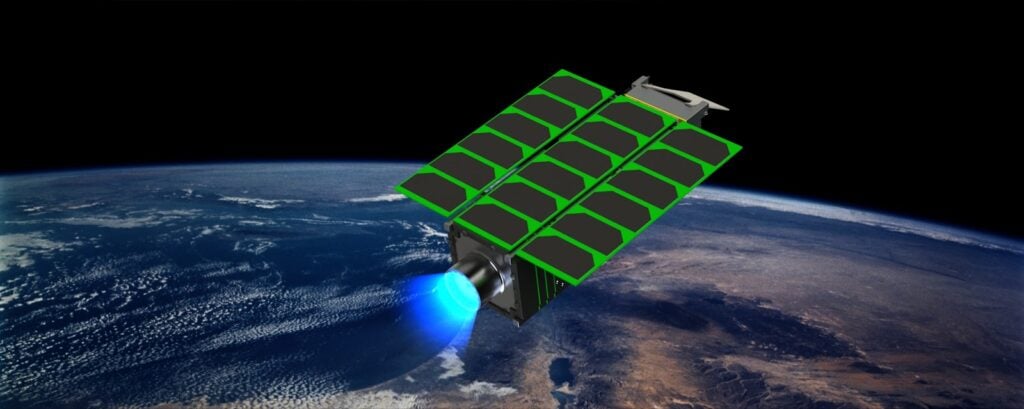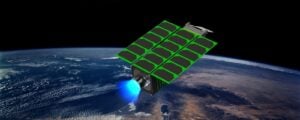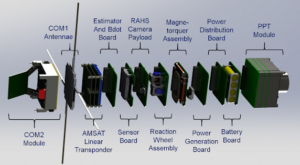The AMSAT News Service bulletins are a free, weekly news and information service of AMSAT, The Radio Amateur Satellite Corporation. ANS publishes news related to Amateur Radio in Space including reports on the activities of a worldwide group of Amateur Radio operators who share an active interest in designing, building, launching and communicating through analog and digital Amateur Radio satellites.
The news feed on http://www.amsat.org publishes news of Amateur Radio in Space as soon as our volunteers can post it.
Please send any amateur satellite news or reports to: [email protected]
You can sign up for free e-mail delivery of the AMSAT News Service Bulletins via the ANS List; to join this list see: http://www.amsat.org/mailman/listinfo/ans
In this edition:
- AMSAT Announces 2020 Field Day Rules
- AMSAT Awards Update
- AO-27 Returns from the Dead
- Updated GOLF Project Information Available
- Changing HuskySat-1 Keps Name in FoxTelem
- Hack-a-Sat Team Boasts Exceptional Participation
- Upcoming Satellite Operations
- ARISS News
- Hamfests, Conventions, Maker Faires, and Other Events
- Satellite Shorts From All Over
SB SAT @ AMSAT $ANS-145.01
ANS-145 AMSAT News Service Weekly Bulletins
AMSAT News Service Bulletin 145.01
From AMSAT HQ KENSINGTON, MD.
DATE 2020-May-24
To All RADIO AMATEURS
BID: $ANS-145.01
AMSAT Announces 2020 Field Day Rules
It’s that time of year again; summer and Field Day! Each year the American Radio Relay League (ARRL) sponsors Field Day as a “picnic, a campout, practice for emergencies, an informal contest and, most of all, FUN!” The Radio Amateur Satellite Corporation (AMSAT) promotes its own version of Field Day for operation via the amateur satellites, held concurrently with the ARRL event.
For 2020, the event takes place during a 27-hour period from 1800 UTC on Saturday June 27, 2020 through 2100 UTC on Sunday June 28, 2020. Those who set up prior to 1800 UTC on June 27 can operate only 24 hours.
AMSAT Director of Contests and Awards Bruce Paige, KK5DO, has an- nounced the rules for the 2020 event.
Paige notes that “AMSAT has followed the ARRL when it comes to the date, times and most rules with regard to Field Day. [ARRL has made some modifications due to COVID-19]. With that in mind, AMSAT is going to have to adapt as well.”
Paige further elaborates, “What we will do for AMSAT Field Day is con- centrate on rovers and operating from home.” In line with this new concentration, the awards issued this year will be modified. The top three club stations will receive certificates as will the top three stations overall (instead of the top three home operators on emergency power). AMSAT will also award certificates to the top three roving stations.
The 2020 rules can be found at https://www.amsat.org/field-day/.
[ANS thanks Bruce Paige, KK5DO, AMSAT Director of Contests and Awards, for the above information]
Due to the COVID-19 pandemic, the AMSAT office
is closed until further notice. For details, please visit
https://www.amsat.org/amsat-office-closed-until-further-notice/
AMSAT Awards Update
This is my first update on the awards for 2020. They used to slowly trickle in. However, over the last two months, there have been a lot of submissions.
AMSAT Satellite Communicators Award for making their first satellite QSO
- Frank Karnauskas, N1UW
- Hiroto Miura, JI8UCI
- Jason Davis, N8PDX
- Andrew Stamp, N2YQO
- Cameron Zotter, K4DCA
- Angus Alexander, KJ7KOJ
- Gustavo Schwartz, PR8KW
- Richard Cutrer, KF5TQT
- Kurt Melden, K1SEA
- William McDermott, KM6MCH
- Robert Smith, KO4CCD
- Bernd Scholer, DL6IAN
——
AMSAT Communications Achievement Award
- Russel Kinner, WA8ZID #624
- Hector Luis Martinez Sis, W5CBF #625 EM30
- Hector Luis Martinez Sis, W5CBF #626 EM21
- Stephan Greene, KS1G #627
——
AMSAT Sexagesimal Satellite Communications Achievement Award
- Hector Luis Martinez Sis, W5CBF #185 EM30
- Hector Luis Martinez Sis, W5CBF #186 EM21
- Stephan Greene, KS1G #187
——
AMSAT Century Club Award Hector
- Luis Martinez Sis, W5CBF #55 EM30
——
AMSAT South Africa Satellite Communications Achievement Award
- Russel Kinner, WA8ZID #US225
- Hector Luis Martinez Sis, W5CBF #US226 EM30
- Hector Luis Martinez Sis, W5CBF #US227 EM21
- Wade Stuart, N0TEL #US228
- Stephan Greene, KS1G #US229
——
AMSAT Robert W. Barbee Jr., W4AMI Award (1,000-4,000)
- John Stone, KC9VGG #98
- Christy Hunter, KB6LTY, #99 (4,000)
- Mitchell Ahrenstorff, AD0HJ #100 (2,000)
- Dave Chasey, N9FN #101
- Paul Overn, KE0PBR #102 (3,000)
- Robert Sours, K9UO #103 (2,000)
- Kell Bodholt, KI7UXT #104 (2,000)
- Wade Stuart, N0TEL #105 (2,000)
- Michael Frazier, KJ5Z #106
- Nicholas Mahr, KE8AKW #107
- Jerod Speck, W4ZXT #108
- Casey Tucker, KI7UNJ #109
——
AMSAT Robert W. Barbee Jr., W4AMI Award (5,000)
- Adrian Liggins, VA3NNA #35
- Christy Hunter, KB6LTY #37
——
AMSAT Rover Award Rover Call
- #051 PR8KW
- #052 LW2DAF
- #053 N0TEL
To see all the awards visit http://www.amsat.org and click on Services then Awards.
[ANS thanks Bruce Paige, KK5DO, AMSAT Director Contests and Awards for the above information]
Looking for the perfect Father’s Day gift?
AMSAT t-shirts are currently 40% off with promo
code BESTDADGIFTS. Other items are 15% off.
25% of the purchase price of each product goes
towards Keeping Amateur Radio in Space
https://www.zazzle.com/amsat_gear
AO-27 Returns from the Dead
A number of amateurs have reported that the FM repeater of AO-27 has been active for brief intervals in recent weeks. When commanded on by control operators, the transponder is active for about two minutes before reverting to telemetry transmissions only.
Patrick Stoddard, WD9EWK, remarks that AO-27 wasn’t originally intended to be an FM satellite. It lacks the audio filtering normally seen with a n FM receiver, since its uplink receiver was going to be used for data. With the lack of audio filtering on the uplink receiver, AO-27 was used for tests with D-Star radios.
The Wayback Machine has captures of the former ao27.org web site, detailing how those tests were done. Two radios were used for those D- Star QSOs, one for uplink and the other for downlink).
Many are hopeful that control stations will eventually be able to recover the satellite sufficiently to provide more regular operation. In the meantime, if you hear the satellite active, make your contacts quickly!
[ANS thanks Patrick Stoddard, WD9EWK/VA7EWK, AMSAT Board Member, for the above information]
Updated GOLF Project Information Available
The AMSAT website has posted updated information on the next series of satellites, intended to succeed the current Fox satellites. AMSAT is developing a satellite program that should see amateur transponders in Low Earth Orbit (LEO), Medium Earth Orbit (MEO) and eventually High Earth Orbit (HEO)
GOLF is an acronym for “Greater Orbit, Larger Footprint”
The goal of the GOLF program is to work by steps through a series of increasingly capable spacecraft to learn skills and systems for which we do not yet have any low-risk experience. Among these are active attitude control, deployable/steerable solar panels, radiation tolerance for Commercial off the Shelf (COTS) components in higher orbits, and propulsion.
The first step is to be one or more Low Earth Orbit (LEO) satellites similar to the existing AO-91 and AO-92, but with technologies needed for higher orbits. With proven technologies, an interim high LEO or Medium Earth Orbit (MEO) satellite would follow on.
The eventual goal is a High Earth Orbit (HEO) similar to AO-10, AO-13, and AO-40, but at a currently affordable cost combined with significantly enhanced capabilities which in turn will allow the use of much less complex ground stations.
Read the AMSAT GOLF article at: https://bit.ly/2WPV9WN
[ANS thanks @amsat and Southgate ARC for the above information]
Need new satellite antennas? Purchase Arrows, Alaskan Arrows,
and M2 LEO-Packs from the AMSAT Store. When you purchase through
AMSAT, a portion of the proceeds goes towards
Keeping Amateur Radio in Space.
https://amsat.org/product-category/hardware/
Changing HuskySat-1 Keps Name in FoxTelem
Instructions for updating FoxTelem (including Fox-in-a-box) so that HuskySat-1 keps are now downloaded as HO-107.
Go to the Spacecraft menu and select Husky (or something else if you have changed the name). In the upper left is a section that says “Name (for Keps)” and the box to the right should say “HuskySat-1”. Just change that to HO-107. Done.
Note that HuskySat-1 is no longer in the downloaded keps, so the one you have will get older and more out-of-date until you change the name. Don’t forget you will need to do something similar with MacDoppler or SatPC32 or any other tracking program you have.
[ANS thanks Burns Fisher, WB1FJ, for the above information]
Hack-a-Sat Team Boasts Exceptional Participation
The Vaporsec “Capture The Flag” (CTF) team, specifically open to amateur radio operators, has seen the largest turnout for a CTF competition in team history, for this satellite-themed event. We have over 20 signed up for the qualifications event this coming weekend. We believe that based on the diversity, quality, and positive can-do spirit, that we have a chance at being competitive and moving on to the final round in late summer.
We had a successful team organizational meeting last night are are looking forward to a Friday 5pm Pacific start time. I’m looking forward to being able to share how amateur radio operators and practical experience carried the day!
The point of the competition seems to be the Air Force wanting to see that the current level of competence is out there with respect to satellite operations and security. Hints have included backgrounders on ADAC, Satellite IoT platform security, protocols, ground control, and more. Rules and link to the Hack-a-Sat website are at: https://www.hackasat.com/
Something that we noticed is that an unsolved challenge in last weekend’s DEFCON CTF qualifier round was from the same team that is putting on Hack-a-Sat CTF.
So! If you are wondering what kind of challenges are posed to participants in a CTF, here is that satellite-themed challenge. We expect this sort of thing to be the starting point for an entire weekend of satellite reverse engineering, puzzle solving, and rogue-craft-wrangling.
There are two files related to the challenge. The challenge text and the two files can be found at: https://bit.ly/2yrFlQM
See you on the other side of the CTF! We will have a write-up of the event and share any and everything we learn along the way.
[ANS thanks Michelle Thompson, W5NYV, AMSAT Board Member, for the above information]
Upcoming Satellite Operations
WY7AA is still in planning stages but on Monday the 26, DN82/DN72 and maybe later DN73/DN74, please watch his twitter page @WY7AA for more details.
Mitch, AD0HJ, has decided to “go check on the tree” in North Dakota. He will be finishing his circuit as this issue is published, but he may still be available on 5/24 UTC in EN06/16 Details on his Twitter page, @ad0hj
Ron, AD0DX, and Doug, N6UA, are making another run at the elusive DL88 in Big Bend National Park, Texas. They tried this grid back in March, and due to the mud couldn’t get to the grid, so never ones to quit, off they go again. The tentative date is Sunday May 31, 2020. They will be using the K5Z call sign. More information is available at the K5Z QRZ Page.
Please submit any additions or corrections to ke0pbr (at) gmail.com
[ANS thanks Paul Overnfor, KE0PBR, AMSAT rover page manager, for the above information]
Want to fly the colors on your own grid expedition?
Get your AMSAT car flag and other neat stuff
from our Zazzle store!
25% of the purchase price of each product goes
towards Keeping Amateur Radio in Space
https://www.zazzle.com/amsat_gear
ARISS News
Amateurs and others around the world may listen in on contacts between amateurs operating in schools and allowing students to interact with astronauts and cosmonauts aboard the International Space Station. The downlink frequency on which to listen is 145.800 MHz worldwide.
ARISS is very aware of the impact that COVID-19 is having on schools and the public in general. As such, we may have last minute cancellations or postponements of school contacts. As always, ARISS will try to provide everyone with near-real-time updates at the ARISS webpage: https://www.ariss.org/
[ANS thanks Charlie Sufana, AJ9N, one of the ARISS operation team mentors for the above information]
AMSAT, along with our ARISS partners, is developing an amateur
radio package, including two-way communication capability, to
be carried on-board Gateway in lunar orbit.
Support AMSAT’s projects today at https://www.amsat.org/donate/
Hamfests, Conventions, Maker Faires, and Other Events
Want to see AMSAT in action or learn more about amateur radio in space? AMSAT Ambassadors provide presentations, demonstrate communicating through amateur satellites, and host information tables at club meetings, hamfests, conventions, maker faires, and other events.
Due to COVID-19, many hamfest and events around the United States have been cancelled or postponed. While we make every effort to ensure the information contained below is correct, there may be some that we missed. We wish all of you safekeeping and hope to be at a hamfest near you soon.
Current schedule: No scheduled events
The following events scheduled to have an AMSAT presence have been CANCELED:
- June 12-13, 2020, Ham-Com, Plano, TX
A copy of the AMSAT hamfest brochure is available for download from: https://bit.ly/2ygVFmV This color brochure is designed to be printed double-sided and folded into a tri-fold handout.
To include your upcoming AMSAT presentation and/or demonstration, please send an email to ambassadors (at) amsat (dot) org.
[ANS thanks Robert Bankston, KE4AL, AMSAT VP-User Services for the above information]
Satellite Shorts From All Over
+ Radio amateur and Executive Chairman of Surrey Satellite Technology Ltd, Sir Martin Sweeting, G3YJO, has recorded a series of home videos from Coronavirus lockdown to record answers to the questions he is most frequently asked. In a recent episode he talks about his inspiration for pioneering the original SmallSats revolution and reveals two of his favourite SSTL missions. Watch Sir Martin Sweeting, G3YJO – Early Years & Favourite Missions at: https://www.youtube.com/watch?v=KV9gQmfmvME
(ANS thanks Drew Glasbrenner, KO4MA, AMSAT VP-Operations, and Doug Shook’s page, www.kc4mcq.us, for the above information)
+ Thailand’s regulator the National Broadcasting and Telecommunications Commission (NBTC) has issued a special callsign to The Radio Amateur Society of Thailand (RAST), founded under the royal patronage of the King of Thailand. The call is E2STAYHOME. RAST will be operating using this callsign on all bands and in all modes, including on NB mode for Es’hail 2 QO-100 geostationary satellite.
(ANS thanks Tanan Rangseeprom, HS1JAN, for the above information)
+ NASA astronauts Robert Behnken Douglas Hurley arrived at the Launch and Landing Facility at NASA’s Kennedy Space Center on Wednesday, May 20, 2020, ahead of SpaceX’s Demo-2 mission. This will be the first launch with astronauts of the SpaceX Crew Dragon spacecraft and Falcon 9 rocket to the International Space Station as part of the agency’s Commercial Crew Program. Behnken and Hurley are scheduled to launch at 4:33 p.m. EDT on Wednesday, May 27, from Launch Complex 39A at the Kennedy Space Center. NASA is inviting the public to help celebrate a historic milestone by participating in NASA’s virtual launch experience at: https://www.nasa.gov/beourguest
(ANS thanks spaceref.com for the above information)
+ According to a new release of Union of Concerned Scientists’ operational satellite database, AMSAT-OSCAR 7 remains the oldest operating satellite in Earth orbit. The next oldest operating satellite is NASA’s TDRS-3, launched 14 years after AO-7 in 1988. Details at: https://www.ucsusa.org/resources/satellite-database
+ All issues of The AMSAT Journal from 2017 to the present are now available for AMSAT members on our new membership portal. More years coming soon. Get logged on today! https://launch.amsat.org/The_AMSAT_Journal
+ Virgin Orbit has announced that the window for its Launch Demo, the first orbital test flight with LauncherOne, opens this weekend on May 24 from 10 a.m. to 2 p.m. Pacific Daylight Time (1700 to 2100z). A backup window for launch is on May 25 during the same time frame.
(ANS thanks Twitter account @Virgin_Orbit for the above information)
+ Another record-shattering QSO was made via RS-44 last night! @KI7UNJ in Oregon worked EB1AO in Spain – a distance of 8,314 km. Both sta- tions had negative elevation! Satellite distance records are maintained at:
https://www.amsat.org/satellite-distance-records/
(ANS thanks Paul Stoetzer, N8HM, AMSAT Executive VP, for the above information)
———————————————————————
/EX
In addition to regular membership, AMSAT offers membership in the President’s Club. Members of the President’s Club, as sustaining donors to AMSAT Project Funds, will be eligible to receive addi- tional benefits. Application forms are available from the AMSAT Office.
Primary and secondary school students are eligible for membership at one-half the standard yearly rate. Post-secondary school students enrolled in at least half time status shall be eligible for the stu- dent rate for a maximum of 6 post-secondary years in this status. Contact Martha at the AMSAT Office for additional student membership information.
73 and Remember to help keep amateur radio in space, This week’s ANS Editor, Casey Tucker, KI7UNJ
ki7unj at amsat dot org


 After a week of testing, the transponder on HuskySat-1 is enabled and open for use and testing. It’s fairly sensitive, and 5-10 watts is plenty most of the time. There are some fades due to satellite orientation, and some passes are definitely better than others. The operations and engineering teams are also watching a few anomalies. Please keep an eye on the beacon during transponder ops, for those with spectrum scopes. Strong signals may impact the beacon strength.
After a week of testing, the transponder on HuskySat-1 is enabled and open for use and testing. It’s fairly sensitive, and 5-10 watts is plenty most of the time. There are some fades due to satellite orientation, and some passes are definitely better than others. The operations and engineering teams are also watching a few anomalies. Please keep an eye on the beacon during transponder ops, for those with spectrum scopes. Strong signals may impact the beacon strength.